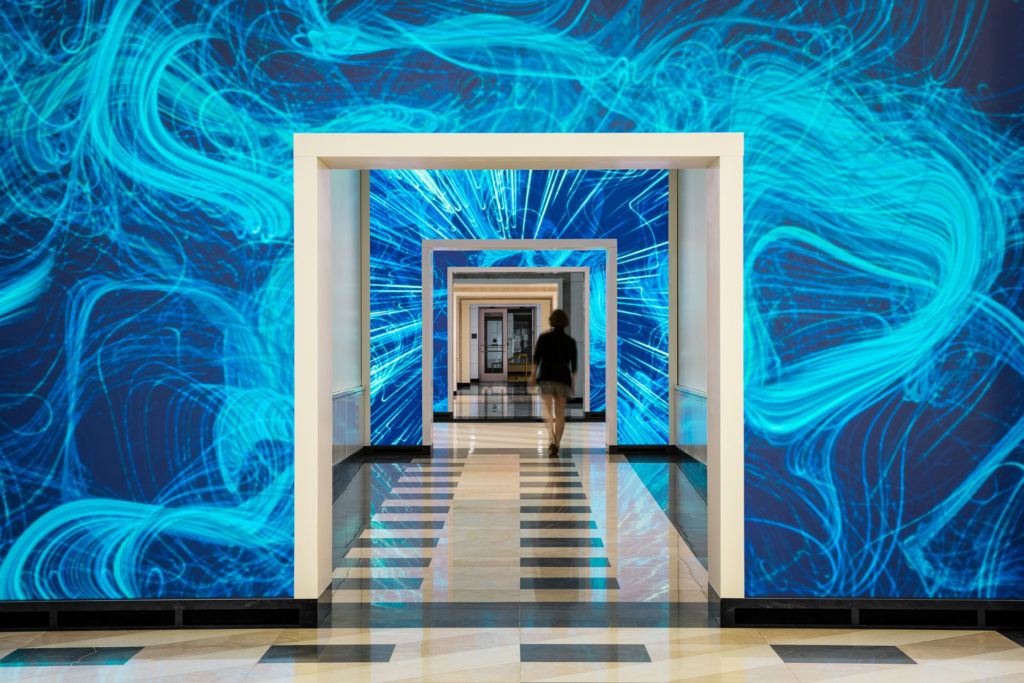How People-Centered Workplace Design Inspires Employees
Posted October 24, 2019
ESI Design’s Head of Media Architecture, Emily Webster, recently wrote for TLNT discussing people-centered workplace design and its implications for employee wellbeing:
Can an office building, workplace, or cityscape have an impact on how we feel — both mentally and physically?
In her fascinating 2017 book, Welcome to Your World: How the Built Environment Shapes Our Lives, architecture critic Sarah Williams Goldhagen takes an in-depth look at the emerging science of architecture and reveals that boring buildings aren’t just an eyesore; being exposed to generic and monotone environments day after day can lead to boredom, unhappiness, and even physical distress.
On the other hand, environments that are rich with texture, nods to nature, and surprising and irregular forms can inspire learning, thinking, and even healing. Studies have shown, for example, that patients heal faster and require less pain medication when they view nature through a hospital window, while the rate of learning among students has been shown to increase in a single year by as much as 16% in a well-designed school.

The implications for workplace and office design are significant. However, traditional office buildings have yet to seize on this research, still placing efficiency ahead of inspiration and utilizing hard, static materials that favor permanence and stability rather than engagement and exhilaration. Such environments don’t feel alive to the modern employee. In today’s digital world, when someone walks into a store they expect dynamic, interactive experiences that immerse them fully in the brand. Why should their expectations be any different for the workplace?
Fortunately, things are changing for the better. Sweeping advances in display and mobile technologies are making it possible — and more affordable than ever before — to design and create workplaces, office buildings, and corporate campuses that offer dynamic, interactive experiences that make people want to come to work every day. Such environments allow companies to connect and engage with employees like never before, while also enhancing their overall wellbeing. Most importantly, if carefully curated and customized for the rhythm and tempo of the physical space, flexible and easily updatable digital displays and media give employees a sense of a fresh and evolving workspace.
As an added bonus, workplaces that make the most of dynamic technology are not only more interesting for employees – they are more effective at attracting and retaining talent. These workplaces create a first impression that characterizes the space as vibrant and modern, while also conveying the company’s vision and identity in a way that’s enthralling and immediate to potential new employees.
VISUALIZE DATA
Visualizing a company’s data is an effective and smart way to provide employees with a way to see exactly how their own work fits into a business’s broader mission and goals. This can deliver a tremendous boost to morale and transform the workforce into a connected, empowered community. Digital displays and media powered by real-time data are also constantly changing and refreshing, offering employees an ongoing opportunity to engage with their company in new and compelling ways.
At eBay’s Silicon Valley campus, a vibrant 20,000-square-foot hub called Main Street showcases a 15-foot touchscreen wall that allows users to explore eBay’s most recent transactions. Other digital installations present the company’s immense wellspring of data as relevant, dynamic and digestible, such as the site’s 10 most popular search terms at a given moment.

By translating numbers into content and statistics into stories, Main Street immerses eBay employees in a rich, comprehensible story about the company’s vast community of users and the enormous volume of products sold through its system every day. It shows them how people use the tools they build and how the work they do affects real people’s lives, while also reminding them that the world’s largest online marketplace isn’t just about sales – it’s about giving people, real people, what they truly want.
It’s also a way for the corporate communications team at eBay to keep these displays fresh and current without much manual up keep. By designing interactive experiences driven by generative data, the story is always told in real time. Main Street, for example, taps into eBay’s transactional data and finds new stories to share about company’s vast community of users and the enormous volume of products.
“Main Street has infused so much more energy, so much more pride amongst our employee base, both here in Silicon Valley and to our employees around the world,” said Wendy Jones, eBay’s senior vice president of global operations. “I don’t think I would have said before that a building could do that, which is pretty incredible.”


Join The Conversation